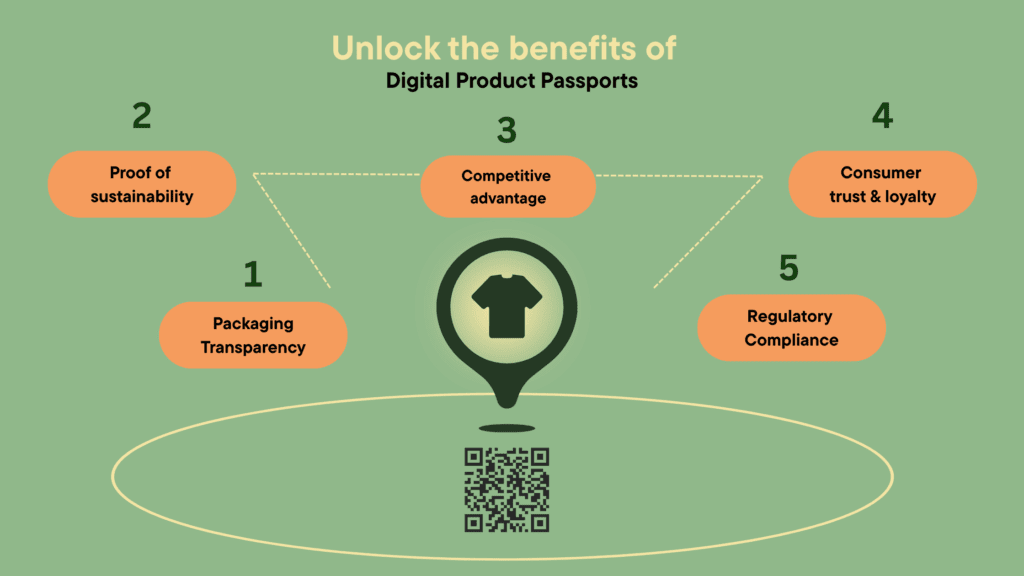Why the Digital Product Passport Matters for Retailers Today
As global regulations and consumer expectations continue to evolve, Digital Product Passports (DPPs) are becoming an essential tool for modern retailers. More than a digital label or QR code, a DPP provides a transparent, traceable account of a product’s lifecycle from raw materials to end-of-life recycling.
Retailers developing collections for 2027 cannot afford to ignore DPPs. The EU’s Digital Product Passport mandate is expected to come into effect across key sectors starting that year, including fashion, electronics, and packaging-intensive goods. That means product development teams need to start embedding traceability, material data collection, and sustainability reporting into their workflows today.
From design to sourcing, the ability to meet DPP requirements will affect everything from supplier relationships to labeling formats to digital content strategies. Waiting until the last minute will be costly both in compliance and competitiveness.
In our latest article we break down the product metrics and why it’s important for retailers to build consumer trust by focusing on packaging transparency and leverage DPP data.
5PUBLISHED: 25 August 2025
Table of contents
What Product Metrics Can a DPP Include And Why They Matter

Digital Product Passports provide a structured, scalable way to surface key environmental and traceability data for each individual product, especially in complex categories like fashion, electronics, home goods, and beauty. This data enables compliance, empowers consumers, and transforms sustainability from a black box into a strategic asset.
Here are essential product-specific metrics a DPP can (and should) include—and why they’re critical:
1. Product Composition
What it includes: Full breakdown of materials used, percentage of recycled or bio-based content, chemical treatments, and material ratios (e.g., 70% organic cotton, 30% elastane).
Why it matters:
- Enables better recyclability assessments and end-of-life decisions.
- Supports material-specific legislation (e.g., textile labelling).
- Builds consumer trust through clear material disclosure.
2. Material Origin
What it includes: Country of origin, production region, and associated certifications (e.g., GOTS, FSC, OEKO-TEX).
Why it matters:
- Increasingly tied to carbon accounting, human rights due diligence, and deforestation risk.
- Essential for scope 3 transparency.
- Supports storytelling around ethical sourcing and traceability.
3. Supply Chain Traceability
What it includes: Tier 1–3 supplier details, transport methods, production energy mix, location-based emissions data.
- Strengthens CSRD/ESPR reporting readiness.
- Helps companies assess and reduce carbon hotspots.
- Critical to model and validate scope 3 emissions (especially upstream).
4. Environmental Performance Metrics
What it includes:
- Product carbon footprint (PCF)
- Water usage
- Circularity indicators (e.g., durability, reusability)
Why it matters:- Shifts sustainability claims from general to measurable.
- Enables automated lifecycle comparisons across SKUs or categories.
- Key to product-level decarbonization strategies.
5. Recycling & End-of-Life Instructions
What it includes: Guidance based on local systems, disassembly steps, compostability, take-back programs, etc.
Why it matters:
- Connects sustainability intent with real consumer action.
- Reduces contamination and landfill risk.
- Ties into EPR compliance and waste reduction targets.

Elevating Packaging Transparency
Packaging has traditionally been a blind spot for many consumers. Labels may disclose some materials, but full transparency on recyclability, origin, carbon footprint, or compliance with environmental standards is rare. DPPs change this.
With a DPP, each product can carry a detailed profile of its packaging, including:
- Materials used (e.g., recycled content, plastic vs. paper)
- Sustainability certifications
- Carbon emissions from packaging production
- Guidance on proper disposal or recycling
This level of transparency isn’t just regulatory, it’s strategic. Packaging is one of the most scrutinized aspects of sustainability, especially in industries like fashion, electronics, and beauty. Retailers who embrace DPPs demonstrate accountability and align with eco-conscious consumer values.
Regulatory Momentum
From the EU’s proposed Ecodesign for Sustainable Products Regulation (ESPR) to Extended Producer Responsibility (EPR) schemes worldwide, legislation is increasingly mandating digital traceability. Retailers who prepare now with DPPs will not only ensure compliance but gain a competitive edge.
Retailers who adopt Digital Product Passports aren’t just ticking a box, they’re future-proofing their operations, elevating transparency, and reshaping how they engage with conscious consumers.
Connecting the Dots: From Data to Competitive Advantage
Each of these data points is not just about compliance, they’re about competitive intelligence. Root’s platform already helps retailers calculate, structure, and centralize many of these metrics at the SKU and material level, meaning DPPs become a natural output not an added burden.
Retailers who move early can turn product data into storytelling, compliance into leadership, and sustainability into something measurable and monetizable.
